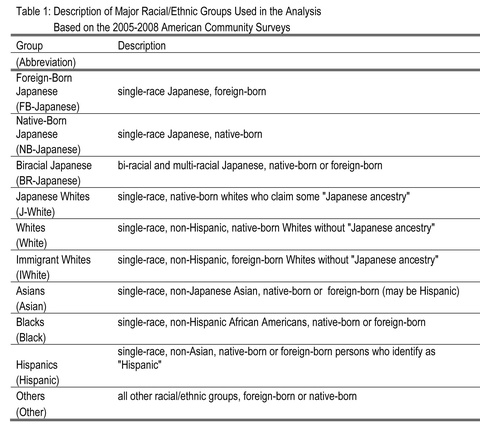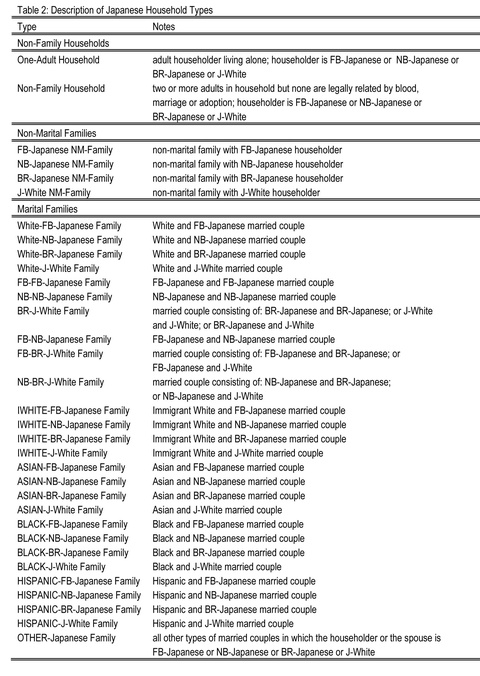>> Part 4
STUDYING CONTEMPORARY JAPANESE AMERICAN FAMILIES
In order to investigate contemporary patterns of the JA family, we use data from the American Community Survey (ACS), which is administered by the U.S. Census Bureau and is representative of the entire household population of the U.S. Our analysis pools together the surveys from 2005, 2006, 2007, and 2008 so that an adequate sample size of a comparatively small demographic group (i.e., Japanese Americans) may be obtained. Our results thus refer to period from 2005 to 2008.
Table 1 describes the categorization of racial/ethnic groups that we have adopted for the purpose of studying the contemporary JA family. Our investigation makes use of the information that is available in the ACS. Following the official classification system currently in use by the U.S. Census Bureau, the ACS classification system identifies Japanese as one group within the Asian racial category. Being Japanese is thus a particular type of racial identity that is recognized in these data. Given our purposes, our analysis obviously needs to distinguish between Japanese versus other Asians as is summarized in Table 1. Furthermore, foreign-born versus native-born Japanese are identified in order to more precisely address issues relating to assimilation, intermarriage, and immigration.
The ACS also allows individuals to have multiple racial identities in that an individual is permitted to identify with as many racial categories as desired. In general, only a tiny proportion of the overall American population identifies as bi-racial or multi-racial, but the proportion is somewhat higher among Asian Americans and other minority groups that have smaller population sizes than whites (Tafoya, Johnson, and Hill 2004; Sakamoto, Kim, and Takei Forthcoming). Given the availability of multi-racial identity in these data, we separate out Japanese Americans who also identify with other racial categories. We use the term “bi-racial Japanese” to refer to such individuals as is summarized in Table 1. By contrast, “single-race Japanese” refer to individuals who identify only as Japanese.
The ACS further allows for individuals to identify their “ancestry” that may be different from their racial identity. Two general sorts of ancestry are distinguished. The first is known as “Hispanic” or “Latino” which is referred to as an “ethnicity” in the ACS questionnaire. The other sort of ancestry is a more general self-identification (permitting the individual write in some response) that is referred to specifically as an “ancestry” and is also provided in the ACS.
Following Takei, Sakamoto, and Woo (2006), we use this ACS information to identify persons who state that they are single-race whites but who have Japanese ancestry. Although this group is not included as part of the JA population in official U.S. Census Bureau publications, Takei, Sakamoto, and Woo’s (2006) analysis of the 2000 Census data reports that there are 102,200 non-Asian persons (most of whom identify as whites) who claim to have some Japanese ancestry but who do not identify as Asian or Japanese as a racial group. These non-Asian persons with Japanese ancestry possibly might include, for example, those who have one grandparent or one great-grandparent who was Japanese. Following Takei, Sakamoto, and Woo (2006), we refer to this group as “Japanese Whites” as is summarized in Table 1.
Due to space limitations, a detailed analysis of other groups is beyond the scope of our study, but several major racial/ethnic categories are identified in our investigation. As described in Table 1, “Whites” refer to single-race, non-Hispanic, native-born whites without any Japanese ancestry. “Immigrant Whites” refer to single-race, non-Hispanic, foreign-born whites without any Japanese ancestry. “Asians” refer to single-race, non-Japanese Asians who are either native-born or foreign-born. “Blacks” refer to single-race, non-Hispanic African Americans who are either native-born or foreign-born. “Hispanics” refer to single-race, non-Asian persons who are either native-born or foreign-born and who identify as “Hispanic” or “Latino.” “Others” refers to the residual category (i.e., anyone not included in the prior categories such as Native Americans and Pacific Islanders).
The particular household types that we identify in our analysis are shown in Table 2. Following up on our earlier discussion about changes in household patterns in contemporary societies, our typology is more detailed than that considered by Kitano and Kitano (1998). First, we explicitly acknowledge one-adult households (i.e., adults living alone) as shown in Table 2. Second, we include non-family households. Third, our analysis identifies families that do not include a married couple, which we refer to as non-marital families. These families are most typically represented by single-parent households with children. Also included in this group, however, are other miscellaneous types of families consisting of related persons without children but no married couple (e.g., an adult son living with his elderly mother). In regard to the JA population, non-marital families are broken down according to whether the householder (i.e., the reference person who is listed first in the questionnaire) is foreign-born Japanese (i.e., FB-Japanese), native-born Japanese (i.e., NB-Japanese), bi-racial Japanese (i.e., BR-Japanese) or Japanese White (i.e., J-White).
Our most detailed classification is used to identify household patterns among marital families (i.e., families that include a married couple). As shown in Table 2, 27 different types of marital families are specified in our analysis. The first four of them refer to each of the four types of Japanese Americans being intermarried with Whites (i.e., White-FB-Japanese family, White-NB-Japanese family, White-BR-Japanese family or White-J-White family).
* The following article is a shortened version of a chapter to appear in Ethnic Families in America: Patterns and Variations, 5th Edition, edited by Roosevelt Wright, Charles H. Mindel, Robert W. Habenstin, and Than Van Tran.
© 2010 Arthur Sakamoto, ChangHwan Kim, and Isao Takei







